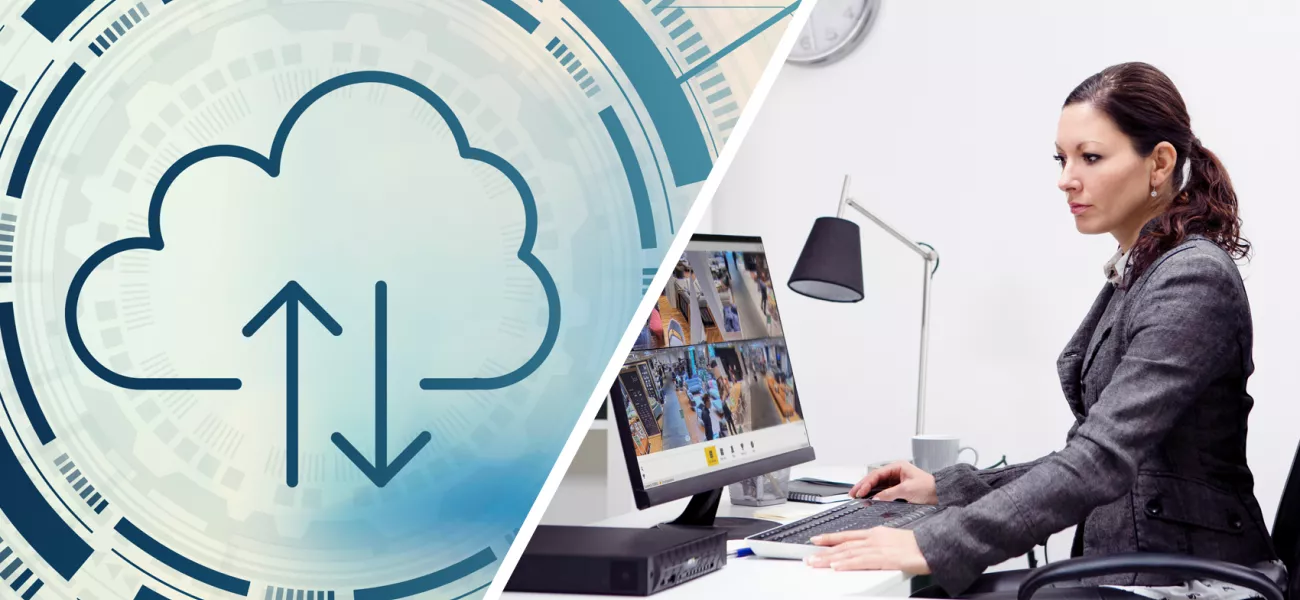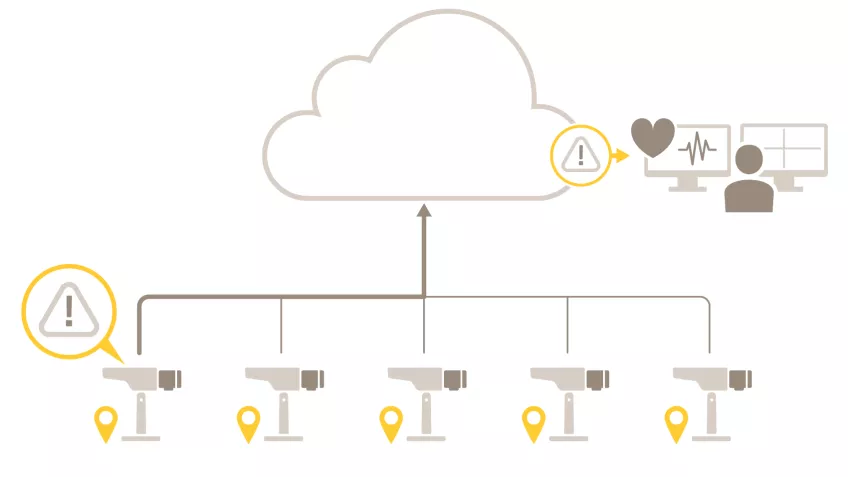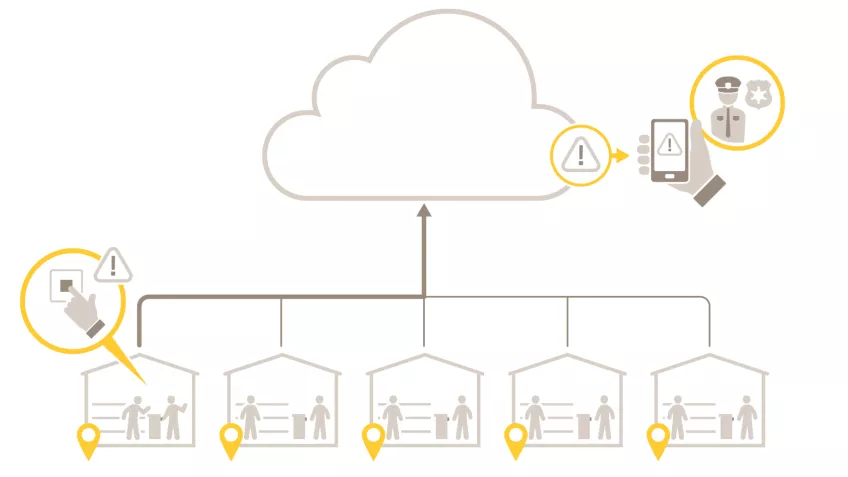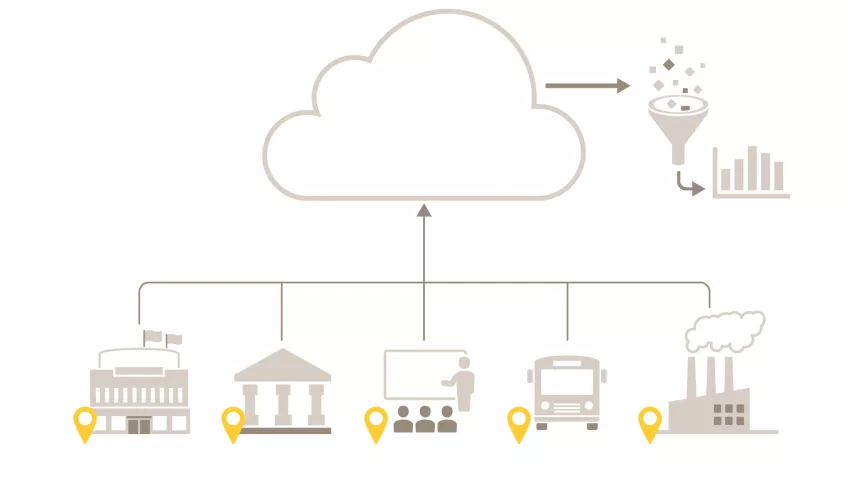
Anyone who uses a computer connected to the internet, or a mobile phone (or, indeed, any number of other connected and ‘smart’ devices) will very likely be using cloud technology in one form or another. In many ways, however, ‘cloud’ has become a catch-all term for a million different services and has therefore lost some of its meaning. Axis is focused on specific use cases for its solutions in line with customer needs, and uses cloud technology in an appropriate way to realize these. Here we look at some of the areas where we see cloud technology as having value in security and surveillance, and where other technologies also play a part.
It’s difficult to put a finger on exactly when the term ‘cloud computing’ was first used (this article in MIT Technology Review looks at its history). Many cite Eric Schmidt of Google’s use of the term in an industry conference in 2006 as the point when the term emerged, though there is also evidence that it had been used many years before that. Wherever you stand on its origins, nobody can deny that over the past decade, ‘cloud computing’ has become a universal term across all industries in relation to technology infrastructure.
In simple terms, the broad definition of cloud computing is running some or all functions of a system on hardware that is situated off-site from a company’s own physical location, or that of its employees, and which is managed and maintained by a third-party service provider.
Again, cloud computing has become something of a ‘catch-all’ phrase, whereas in reality it can be delivered in many different forms, including Software-as-a-Service (SaaS), Platform-as-a-Service (PaaS) and Infrastructure-as-a-Service (IaaS). Increasingly, there are sector and application-specific versions of all-encompassing cloud solutions including, in our sector, Video Surveillance-as-a-Service (VSaaS)
While cloud technologies are often presented as the ideal solution to all an organization’s needs, for very good reasons they’re not ideal in every scenario, all the time. The use of cloud technologies in security and surveillance is no exception.
Using cloud where it has most impact
At Axis, we’re always led by meeting the needs of the customer. We utilize the best of each instance - edge devices, server/appliances and cloud - in order to provide the most optimal and flexible solution for customers. This is also reflected in our use of open platforms for our technologies, and in our partnership model, which allows customers to find the best partner and applications to suit their needs.
There are some very good reasons why a solution based purely on cloud won’t be optimal for all customers, or perhaps even most of them. At the most fundamental level, cloud computing of any sort requires a robust and reliable internet connection, and that’s not something that’s always available in every situation.
Some companies will be running critical operations handling sensitive information and need to keep all data on the premises – either through their own governance or compliance with regulation - and are therefore unlikely to consider a cloud solution. Example of companies in this area might be banks, powerplants, hospitals, critical governmental operations, etc.
In these cases, both physical and system security will protect critical data, and both of these are in the total control of the end-customer: they have the knowledge and experience and are not willing to outsource this to a third-party. An on-premise ‘air gapped’ solution – i.e. one not connected to the internet – such as AXIS Camera Station will meet their demand. However, on-site air gapped systems like AXIS Camera Station needs to be maintained to optimize performance.
A cloud-based system will result in more exposure on the internet. It can still be well-protected, but this totally relies on a third-party supplier’s ability to secure the system information. That said, a cloud system is instead more easily updated, with fixes distributed immediately by the service provider. AXIS Companion is this kind of system. Businesses handling less sensitive information are more likely to be willing to rely on third-party service providers to update the solution.
Finally, some of the significant advantages in edge computing, where analytics is embedded in the camera itself, and therefore closer to the source of the image, makes it a much more compelling solution than use of cloud-based analytics. Where existing cameras do not have edge analytics capabilities, the combination of edge, server and cloud can be the most cost-effective solution for customers.
Where Axis makes use of cloud technologies
As discussed, ‘cloud’ as a catch-all term for remote computing resources isn’t very useful. It’s far more relevant to look at specific uses of cloud in our delivery of surveillance and security solutions.
Cloud technologies are used throughout Axis end-to-end solutions for surveillance using our own Video Management Software (VMS), AXIS Companion and AXIS Camera Station.
Here are some of the specific areas where cloud technology is employed across Axis solutions:

Axis Secure Remote Access: Axis Secure Remote Access is a technology that makes it possible for a smartphone or PC client to access Axis network cameras and recorders when the client and the cameras are located on different local networks. Using external mediator servers that are hosted or controlled by Axis, a client and a camera can find each other and establish a secure peer-to-peer connection. Secure communication is in the core of Axis Secure Remote Access: the technology uses multiple levels of authentication to establish an encrypted communication between a client and the cameras in the surveillance system.

System health monitoring and management: Operators use cloud technology to connect to different sites in the system. From one central location an operator can control and manage all the devices in the system, allowing them to monitor and receive notification of device status, upgrade device firmware, perform remote restart, and manage user rights.

Event notifications: Events – increasingly triggered through edge analytics in the camera - provide immediate attention to operator through notifications, prompting them to take action. Notifications - which can be delivered to an operator’s mobile phone - might relate to a specific incident viewed by a surveillance camera which triggers an alarm, or prompted by a device malfunction.

Data sharing for efficiency and management: Sharing data across services and solutions delivers a number of advantages to customers in system administration and management. For instance, management and administration of licenses is handled in the cloud, making it easy for our customers to manage devices licenses across their entire system. Users of AXIS Companion and AXIS Camera Station can provide anonymized data to Axis to improve their system, such as the number of connected devices, device types, successful upgrades, server/client failures, etc. While data about cloud-based services gives customers a real-time view of service status.
Deploying cloud appropriately for customer benefits
It can be too easy to jump on the ‘buzzword bandwagon’ when technologies appear, assuming that specific benefits in efficiency and cost are appropriate for all use cases. But this is rarely the case. Axis continually reviews the appropriate use of all technologies – both existing and new – in its solutions, but always through the lens of customer need, benefit and value.
Cloud technology plays a central role in our end-to-end solutions, and will no doubt be used in more areas as the technology evolves. Our customers can rest assured that Axis will be offering solutions that employ the best use of cloud in line with their organizational objectives, bringing optimal benefits in flexibility, effectiveness and efficiency to their safety and security.